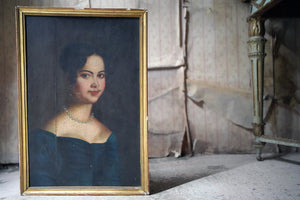A Unique Irish Carved Fruitwood & Burl Root Folk Art Figure of a Lady Playing a Harp c.1860
$3,437.00
Origin: Irish
Period: Mid-Victorian
Provenance: Unknown
Date: c.1860
Height: 15”
Width: 6.5”
Depth: 4”
The extraordinary and unique primitive folk art figure of a lady playing a harp, her face wonderfully expressive, being hand carved from fruitwood and using the burls of the wood to form parts of the figure naturally, flowing to an integral circular base, the whole surviving from nineteenth century Ireland.
The condition of the figure is good considering the relative fragility. The right hand is articulated and still moves to allow her to move ‘play’ the harp. Three of the strings are later replacements but this was administered by an expert and thus it is not noticeable. There is some very sporadic woodworm which is not active.
The family who previously owned this figure was an old English Family that has a distinguished Military Background. She was brought back, by a serving military member of family, from Ireland during the19th century and the family folklore stated that members had heard a harp playing in the house.
Since the 13th century, the harp had been considered the heraldic symbol of Ireland. Referred to as the Celtic harp, Gaelic harp or cláirseach in Gaeilge, the native Irish tongue, the emblem of the nation is found on flags, coats of arms, passports, currency and even the packaging of various forms of libation.
Pieces of folk art are ephemeral, simple, and often crude, though they are always enchanting. They were made by unskilled people, usually provincially, for everyday use and enjoyment, and are naively decorated, and made of basic materials. Folk art provides an excellent insight into the everyday life of ordinary people in times of old, and for that reason we love it.
A unique and utterly beguiling piece of folk art.
“But my body was like a harp and her words and gestures were like fingers running upon the wires.” - James Joyce ("Araby", The Dubliners)
2705
2750.00
Period: Mid-Victorian
Provenance: Unknown
Date: c.1860
Height: 15”
Width: 6.5”
Depth: 4”
The extraordinary and unique primitive folk art figure of a lady playing a harp, her face wonderfully expressive, being hand carved from fruitwood and using the burls of the wood to form parts of the figure naturally, flowing to an integral circular base, the whole surviving from nineteenth century Ireland.
The condition of the figure is good considering the relative fragility. The right hand is articulated and still moves to allow her to move ‘play’ the harp. Three of the strings are later replacements but this was administered by an expert and thus it is not noticeable. There is some very sporadic woodworm which is not active.
The family who previously owned this figure was an old English Family that has a distinguished Military Background. She was brought back, by a serving military member of family, from Ireland during the19th century and the family folklore stated that members had heard a harp playing in the house.
Since the 13th century, the harp had been considered the heraldic symbol of Ireland. Referred to as the Celtic harp, Gaelic harp or cláirseach in Gaeilge, the native Irish tongue, the emblem of the nation is found on flags, coats of arms, passports, currency and even the packaging of various forms of libation.
Pieces of folk art are ephemeral, simple, and often crude, though they are always enchanting. They were made by unskilled people, usually provincially, for everyday use and enjoyment, and are naively decorated, and made of basic materials. Folk art provides an excellent insight into the everyday life of ordinary people in times of old, and for that reason we love it.
A unique and utterly beguiling piece of folk art.
“But my body was like a harp and her words and gestures were like fingers running upon the wires.” - James Joyce ("Araby", The Dubliners)
2705
2750.00
























